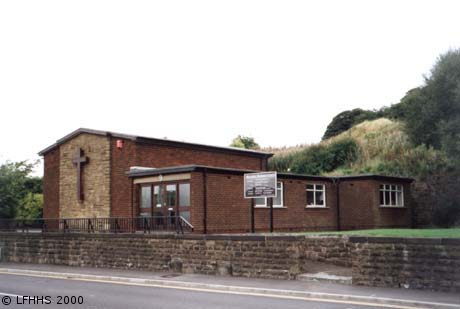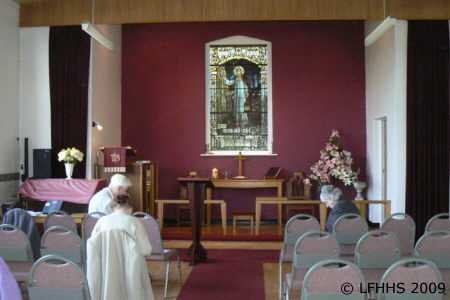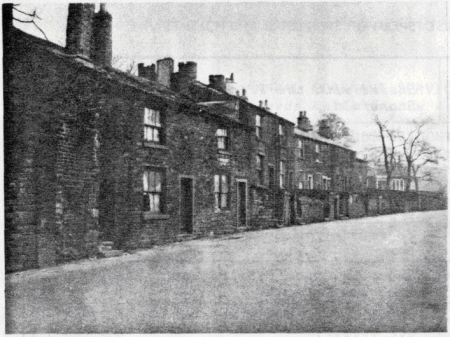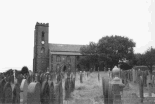Baxenden Methodist Church
Blackburn Road, Rising Bridge


The following passage is taken from the 150th Anniversary Booklet - 1985
The early years
Where do you begin to tell the story of a Christian Community? Are we most concerned with its life together as a church or with the history of its buildings?
Briefly you can never tell the whole story because such a history is the history of people - and people do not always record their activities to the desire of students of history with a degree of collaboration. The activities of such people, it is true, live on in the minds of those who were touched by those saints of old and who, in turn are touching the hearts of a new generation.
This is the story of one branch of the ongoing history of Christ's church which this year reaches a significant milestone of service to the communities of Baxenden, (from which the chapel takes its name), Rising Bridge and the northern reaches of Haslingden. One hundred and fifty years since Methodist work was firmly established in this area. We could catalogue our history by simply listing significant dates but this would not tell the whole story ...
We could catalogue our history by simply listing the brothers and sisters of a bygone age but in some ways this would only make our history interesting to those whose memories are long enough for the names to mean anything.
How then shall we proceed? I said at the beginning that the history of a church is the history of a people and how they are moved by the Spirit of God and so that is how we shall tackle the history as a movement of the people of God. At such an anniversary as this there is opportunity for nostalgia and for looking back but we need always to look forwards, taking stock of where we are and where , under the guidance of God we shall be going.
The first references to a worshipping congregation in Baxanden can be found in the Circuit Plan for Haslingden in 1916 with the report of house services, monthly 'at 7 o'clock in the evening'. Services are recorded as having been held at 633 Manchester Road when the preacher was Mr Jack Grimshaw. Until 1835 the society in this place was a branch of the King Street Society in Haslingden - the culmination of a long period of Methodist activity in the village. It is believed that as John Wesley travelled from Huncoat to Stonefold in 1786 he would have found a small group of Methodists in the village, probably due to the activities of 'Scotch Will' a Methodist evangelist (real name William Darney) who devoted his life to missioning in Lancashire and Yorkshire - a rough and ready poem from his pen links to this part of Lancashire with its reference to 'Sherfin side' the old name for the path along which Wesley would have travelled on his journey:
Likewise in Rossendale
In New Hay Hey and Oakey Wood
Christ has become their all.
In mercy Lord 0 Look Thou down
On those about Goodshaw;
For many of thy lambs are torn
By wolves who cunning be
At Sherfin side and Brimicroft
The work it is begun
And Satan's soldiers they do fight
For fear we take Blackburn!
We can be sure, from many references that there was a growing company of Methodists meeting in Baxenden, meeting in houses and wherever they could gain admittance.
In 1835 the Sunday School was built on land 'bought’ from Mr John Hall for £43/10/00. We say 'bought’ because on the preceding page an entry is shown for a donation to the building fund of £44 from the same gentleman. A generosity repeated several years later in 1878 when the chapel was built. An interesting extract from the original trust sets out quite clearly the intentions of those who with great personal sacrifice and personal effort made this commitment and step in faith:
"enter into, have use and enjoy the said premises and school house so as aforesaid intended to be errected thereon and to preach and expound God's Holy Word and perform all the acts of Divine Worship, provided always that the persons so appointed shall preach and hold forth no other doctrine than such is contained or agreeable to the four volumes of sermons (first published) and Notes on the New Testament by the said John Wesley",
(Modern preachers take note! )
From the very first, then, the social outreach and the school was contained within a worship setting clearly indicating that their concern for the community in which they were set grew from their understanding of Christ's exhortations. Their concern for education led to the eventual setting up of the day-school (1859) at which time the Sunday School ceased to teach writing, reading and spelling. The school became recognised as an elementary school under the Education Act of 1863.
The mid-1850s saw the beginning of the chapel which was opened for divine worship on March 6th 1659. It is recorded that music played an important part in the worshipping life of the church, to quote the Centenary booklet:
"the singing was led by an assortment of wind and string instruments, amongst which were clarinets bassoons flutes, fiddles, trombones and ophicliedes (locally known as 'the serpent'). The first choir Master was Mr John Holt whose only 'instrument' was a tuning fork".
(An organ was not available until 1922)
The church and school underwent several changes as part of a constant process of refurbishment and renewal through to the centenary of the Methodist work in 1935.
An interesting insight into the way that funds were raised in the 'good old days' is given in the Centenary booklet in the reminiscences of Mr Birtwistle, the grandfather of our present Finance Committee 5ecretary.
The original plan (for the chapel) did not include a vestry. This was obviously giving concern to one of the local officials and John Nuttall, taking the arm of one of the visiting Wilson's pointed this out to him saying, "Mr Benjamin, this will never do" . "What will never do, John?"
"Why there is no vestry or any other sort of room shown here." "What do you want with a vestry, John?" "Why! Where have we to count the collection and do other things connected with the chapel. Have we to do this before the congregation?" "No, John, that will never do; just see what our Thomas says, and the other gentleman. I'll be another £20 before you shall be without a vestry."
(The vestry was duly added to the scheme!)
Throughout its history the chapel and school underwent many building improvements, adapting and developing to meet new needs of the church and community. The debts for such work being cleared with consistent enthusiasm.
It the mid 1950s the ongoing battle against ageing buildings and the scourge of dry rot was beginning to become too much for the society and plans were begun to completely rebuild - this scheme was acknowledged by all to be too ambitious and much discussion and heart-searching, went into the decision, taken by a new trust setup in 1966 to demolish the old buildings and to build a much smaller, easier to maintain, multi-purpose building.
It would be easy to dismiss the heartache that must have gone into this decision from many who would have cherished the old building. But the decision was taken in great faith and from the remnant of the old building grew a fine modern building that has served the community well for the last fifteen years.
The history of the last fifteen years echoes much of the past 150! An ongoing care for young people (through the Sunday School and various activities over the years) and an ongoing care for the worship of God. Many have given much to maintain the work and witness of the Methodist cause in this community and we salute them all - in some ways it is wrong to 'name names' because we can so easily miss someone out - each has contributed their part according to their God given talents and time. We have now built and consolidated on the past and we begin to look to the future .
What next?
We stand now at a sort of cross roads. We seek a way forward.
How can we continue the long tradition of Baxenden in reaching out to the future? How can we develop and strengthen in the faith those who already belong? How can we reach out in new and exciting ways, especially in this International Year of Youth, to extend our work amongst children and young people, so long part of our traditional emphasis here? How can we build up new ways of responding to the needs of the community? that is the role for the church here at Baxenden in the future?
These and many ether questions must be in our minds as we approach and fulfill all the hopes and expectations that such an anniversary offer to us. How are we to respond?
We still hold an important place for our worship and this has been fostered during this last year by the formation of a Worship Consultation, we hope that the Worship Consultation may be able to Seek new and exciting ways to make our worship challenging for the future. Can we establish some kind of fellowship or Bible Study for the nurture of our faith toqether? We hope to begin a new piece of Youth work in the early part of 1985, can we find ways to encourage and develop this side of our work, building on the fine work that the Sunday School already does? Is there anything that we can do to forge greater links with the communities in which we are set? Can we develop our pastoral care to include all of those who are adherents as well as those who are members of the church to be a vision of the Kingdom to the community? How can we search out new ways to work for Christ in the community?
In short this year needs to be a time of growth and development and of building upon the past - we must not allow this time to be simply a nostalgic look back at what we have been. Our greatest testimony to our 150 years of history is to build for the bi-centenary in 2035 - why not book the date in your diary.
WE GRATEFULLY ACKNOWLEDGE THE HELP OF HOLLANDS PIES
WITH THE PRODUCTION COSTS OF THIS BOOKLET - THANKS.

Manchester Road Baxenden early 20th Century




